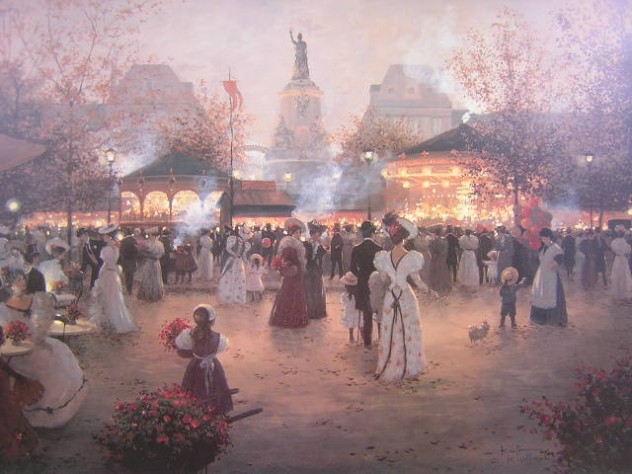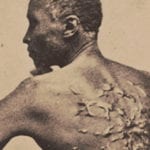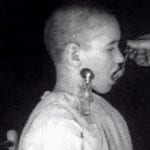 Animals
Animals  Animals
Animals  Weird Stuff
Weird Stuff 10 Weird Things That Warp Your Sense of Time
 Miscellaneous
Miscellaneous Ten More Extremely Unexpected U.S. State “Firsts”
 Humans
Humans 10 Ideas That Scare People to Death
 Music
Music The Cursed Decade: 10 Classic Rock Stars Who Had Low Periods in the 1980s
 Health
Health 10 Crazy Ways Sleep Deprivation Can Affect You
 History
History 10 Enthralling Facts about the Field of Cloth of Gold
 Pop Culture
Pop Culture The Ten Greatest Engineers in Science Fiction History
 Humans
Humans Ten Journalists Who Got Caught Faking the News
 Travel
Travel 10 Best Hiking Trails in America with Breathtaking Views
 Animals
Animals Ten Animals That Produce and Store Toxins in Unlikely Places
 Weird Stuff
Weird Stuff 10 Weird Things That Warp Your Sense of Time
 Miscellaneous
Miscellaneous Ten More Extremely Unexpected U.S. State “Firsts”
Who's Behind Listverse?

Jamie Frater
Head Editor
Jamie founded Listverse due to an insatiable desire to share fascinating, obscure, and bizarre facts. He has been a guest speaker on numerous national radio and television stations and is a five time published author.
More About Us Humans
Humans 10 Ideas That Scare People to Death
 Music
Music The Cursed Decade: 10 Classic Rock Stars Who Had Low Periods in the 1980s
 Health
Health 10 Crazy Ways Sleep Deprivation Can Affect You
 History
History 10 Enthralling Facts about the Field of Cloth of Gold
 Pop Culture
Pop Culture The Ten Greatest Engineers in Science Fiction History
 Humans
Humans Ten Journalists Who Got Caught Faking the News
 Travel
Travel 10 Best Hiking Trails in America with Breathtaking Views
10 Horrible Historic Homicides
In a sense, the history of man is the history of murder. From the time the first hominid knowingly, and with malice aforethought, whacked another hominid on the head with a blunt instrument, our species has demonstrated a tendency to kill each other.
Sometimes, victims are let go gently into that good night, or die swiftly in a fit of rage or passion. However, some murderers dispose of their victims the way an imaginative, Hollywood-style serial killer takes care of his hapless prey: with deliberate, sickening, spine-chilling bloodshed, and occasional dismemberment.
10 “A Wholesale Murder”
August 1866

On a farm in Schleswig-Holstein, Germany, a house fire in the middle of the night brought neighbors from adjoining farms rushing to put out the conflagration. Inside, they discovered the charred and mutilated remains of eight people: seven members of the Thode family and an eighteen-year-old maidservant. It was clear from the wounds that the victims had been violently stabbed as well as struck with a hatchet. In particular, the eight-year-old daughter was so covered with deep cuts, investigators at first believed she’d been tortured.
Was the family killed by thieves looking for the father’s hidden strongboxes full of silver? Twenty-three-year-old Timm Thode, the only survivor, fell under suspicion. He had constantly argued with his frugal, somewhat reclusive father over money. On the night of the fire, witnesses testified his clothing was bloodstained. Timm claimed he’d been awakened by the fire and fled to a neighbor’s house, but under interrogation, he confessed to the murders. His motive? Greed, pure and simple.
Timm Thode was tried, condemned to death, and executed.
9 “God Accused Of Breaking His Promise”
May 1879

In Pocasset, Massachusetts, a farmer named Charles F. Freeman converted to a Christian sect, the Second Advent Congregation. Becoming inflamed with religious fervor at the revival meetings, he believed he’d received a communication directly from God ordering him to sacrifice his five-year-old daughter, Edith. The voice of God also promised a miracle—if Freeman obeyed, his dead child would be resurrected on Sunday.
Improvising an altar on the kitchen table, Freeman stabbed Edith to death with a knife on Thursday morning at dawn. Afterward, he called a meeting of his church and proudly showed the horrified congregation what he’d done before driving everyone out of the house and barricading the doors and windows to await a miracle that never came. After his arrest, he sang hymns and claimed to be a “second Abraham.” Some followers of the church absolved Freeman of the crime, claiming God had broken the promise to resurrect the child.
Freeman was remanded to the State Lunatic Hospital in Danvers.
8 “Thrown Into A Well”
April 1868

James Killey, 33 years old and a small-time miner and farmer, lived with his wife, Esther, and five young daughters—aged from seven years to three months old—on a farm near Foxdale on the Isle of Man. According to Esther, Killey was a hard worker, a decent provider, and a good father, which made it all the more puzzling when his behavior suddenly changed. He became sullen and depressed, and began to express violent and suicidal thoughts.
One morning after a sleepless night, Killey went outside where his children played in the yard. A little while later, hearing a scream, an alarmed Esther ran out into the yard with the baby in her arms to find her husband standing over the well, grasping one of the girls. There was no sign of the others. Killey dropped his daughter down the well, snatched the three-month-old from Esther, hurled the infant into the well, and finally jumped in himself.
Fortunately, a relative, Archibald Schimm, worked on the farm and came running to help. He managed to rescue two of the older girls. The rest were dead, including the father. All had drowned in the well. The inquest ruled Killey had committed the murders in a state of temporary insanity. His reason for killing his daughters remains unknown.
7 “Dreadful Barbarity”
June 1871

At the Hall End Colliery (coal pit) in West Bromwich, England, the body of Joseph Marshall was discovered by an engine tender. The 50-year-old laborer lay on the ground in front of a roaring fire. Someone had covered the right side of his body with blazing hot coals, possibly to prevent identification. His stockings were burnt off his legs, his leather belt had been almost entirely consumed, but his head remained intact.
Investigators soon uncovered deep lacerations and holes in the victim’s skull that pointed to murder. A search of the victim’s nearby hovel revealed a pair of rakes and a hammer which had caused the awful head wounds. Witnesses pointed to John Higginson, another laborer who’d been seen drinking with the victim on the night of the murder. Higginson had also been spotted leaving the victim’s hovel before the body was uncovered.
For some unknown reason, the jury found Higginson guilty of manslaughter and sentenced him to penal servitude for life. Why he killed Marshall remains a mystery.
6 “The Headless Horror”
February 1896

Near Fort Thomas, Kentucky, a young boy walking to town found a woman laying face down on the side of the road, her long skirt flipped over to cover her face. Assuming she was drunk or asleep, he continued on his way and alerted the authorities. The deputy sheriff went to the scene and discovered the woman was dead. When he turned over the body and pulled down the dress, he was shocked to find the victim’s head missing.
The unknown victim’s clothing was torn, her corset ripped off, and her underclothing cut and covered in bloody fingerprints. She had a defensive wound on her hand. However, the autopsy did not uncover any physical signs of rape. She’d been five months pregnant at the time of her death, judged to be due to manual strangulation from bruises on the stump of her neck. Her identity remained unknown until Fred Bryan of Greencastle, Indiana, brother of 22-year-old Pearl, came forward to report his sister missing.
The story became clearer to investigators. Impressionable, pretty Pearl had become the lover of Scott Jackson, a handsome ladies’ man. He’d broken off the relationship with her earlier, but Pearl discovered their affair had left her pregnant. In a panic, she contacted him. He made promises he didn’t keep. When she threatened to reveal his duplicity to her family, Jackson took Pearl to a field. After his strangulation attempt failed in her fight for her life, he cut her throat, decapitated her, and staged the scene to look like rape.
When he was arrested, Jackson’s arm still bore the raw scratches made by Pearl’s fingernails. His friend, Alonzo Walling, was accused of assisting Jackson to commit the murder. Both Jackson and Walling were hanged.
5 “The Splendid Darling”
March 1886

Henri Jacques Pranzini, born in Alexandria, Egypt, was good-looking, refined, and intelligent—a “splendid darling” according to the many women attracted to his charms. He worked as a translator, but also led a secret life as a gambler, thief, and professional liar who earned his real living conning money out of his female victims.
In Paris, Pranzini met Marie Regnault, an apparently depressed mother of an 11-year-old girl. She eagerly adopted his debauched lifestyle. While not rich, she had a stash of jewelry, bonds, and other valuables. Pranzini wooed her for about a month before he struck. He was seen entering Marie’s house with a carving knife. The following morning, the bodies of Marie, her child, and a servant were found dead at the blood-soaked scene, their throats cut.
Pranzini fled to Marseilles, where he was caught with some of the victim’s jewelry. He’d also boasted about the murder to a reporter, imparting knowledge only the killer could have known. After his arrest, he claimed he’d spent the night at a lady’s house, but of course, declined to name the woman in question. The jury sentenced him to death. He maintained his innocence, even as he was led up the steps of the guillotine. As related in a previous list, his body was supposedly flayed and the skin used to make a cigar case.
4 “Somnambulist Tragedy”
October 1845

Twenty-one-year-old Maria “Mary” Bickford worked as a prostitute in brothels in Boston and New Bedford, Massachusetts. She was young, fashionable, and beautiful until she was found in her boardinghouse room, her throat savagely cut, blood splattered on the walls, and her bed on fire. The flames had destroyed her face and hair, but not the evidence her murderer had left behind: a bloody razor, men’s clothing, and letters to Maria from an “A.J.T.”
Albert Jackson Tirrell, 22 years old, had already scandalized the city by leaving his wife and children to live with Maria and squandering a fortune on her. The besotted man was under indictment for adultery. He was the last one to see Maria alive. More damning, he fled ahead of the authorities to Canada on his way to Liverpool, but bad weather forced the ship to dock in New York City. He was caught on his way to New Orleans.
Because he claimed to have no motive for murder, Tirrell and the legal team hired by his family attempted a groundbreaking defense. Tirrell was known to sleepwalk, so if he had done it—no admission of guilt intended—it wasn’t his fault. After hearing Maria painted as a depraved Jezebel and a heartless seductress, the jury found Tirrell not guilty of murder.
3 “Shocking Discoveries”
October 1892

In Australia, as in England and America at the time, the practice of “baby farming” was a legal, commercial practice—a mother (often unwed) who couldn’t care for her infant would pay someone to take care of it for her, usually for a weekly fee. Promises of adoption were sometimes made. However, if a baby died, the fee might continue to be collected from the ignorant parent. Not all “professional child minders” committed murder, but . . .
The decomposing bodies of two babies wrapped in stinking clothing were found by a worker in a drain behind a house in a Sydney suburb. Authorities found five more infants buried on the property and tracked down the owner: John Makin, who lived with his wife, Sarah Jane, and four daughters. The Makins were baby farmers. When their new home was searched, more bodies were found buried, making 12 in all. Arrests were made immediately.
The trial played out to a packed courtroom. John and Sarah Makin stood accused of the murder of one of their charges, Horace Murray, whose mother, Amber, acted as the prosecution’s star witness. The most damning evidence against the defendants came from their 16-year-old daughter, who testified against them. John and Sarah were given the death sentence. After exhausting all appeals, John met his end on the gallows. Sarah’s sentence was commuted to life in prison with hard labor. She died after serving 19 years.
2“Terrible Discovery In Bog”
October 1849

Patrick Moore was a cruel man. Frequently drunk, he abused his wife, Catherine (née Thompson), the prettiest girl in Tolerton, a village in Ireland where they lived. She still had many admirers among the young men. Jealousy often sent her alcoholic husband into violent rages that turned physical. Eventually, she went to her mother’s house, but her unhappiness continued to fester. A few weeks later, Patrick mysteriously disappeared.
His relatives heard he’d left for America, but why not take Catherine with him? She made excuses and departed for Liverpool the next Sunday, presumably to catch a boat to New York City and join her husband. However, no one heard from Patrick, which seemed unlike him. About a month later, a man’s putrefying body was found in the isolated Rossmore bog.
The victim had not only been worried by dogs, but the killer had mutilated the face, gouging out the eyes and making such deep lacerations that his features were unrecognizable. The body fell apart when it was collected. A police inspector found someone willing to identify the remains as Patrick Moore, and Catherine was arrested when she returned from Liverpool. She confessed to Patrick’s murder and named her mother, Brigit, as an accomplice.
Both women were found guilty of murder and sentenced to be hanged.
1 “What Child Is This?”
March 1851

When Martha Clarke, 22 years old, let herself be seduced by the promises of a man who abandoned her, she was left alone, unmarried, and heavily pregnant. She entered a workhouse and gave birth to a son, Arthur, around Christmas 1850. It wasn’t a joyous occasion. Destitute, her future ruined, she left the workhouse with her baby in March 1851.
The next night, Martha was seen in Suffolk (England) near Bury St. Edmonds, carrying her baby and a shovel. At eight o’clock, she arrived at her stepmother’s house without Arthur. When questioned about the baby, her story kept changing. She said she’d sent him to live with her aunt, or sent him away to another family, or put him in school. Her stepmother was suspicious, but let Martha eat supper and go to bed.
Over breakfast the following morning, the stepmother expressed her opinion that Martha had murdered the baby. Martha calmly replied that she hadn’t killed Arthur. She’d only buried him alive. The confession caused a panic. A local constable was summoned. The field was searched. At midnight, Arthur Clarke’s lifeless little body was recovered from the grave Martha had carefully dug and concealed. She was arrested for suffocating her child.
Because she’d taken so much care to hide the body, her temporary insanity defense was rejected by the judge. The jury found Martha guilty, and she was sentenced to hang.








